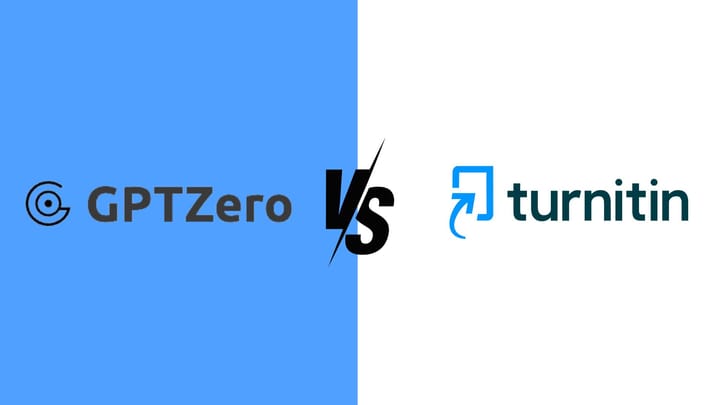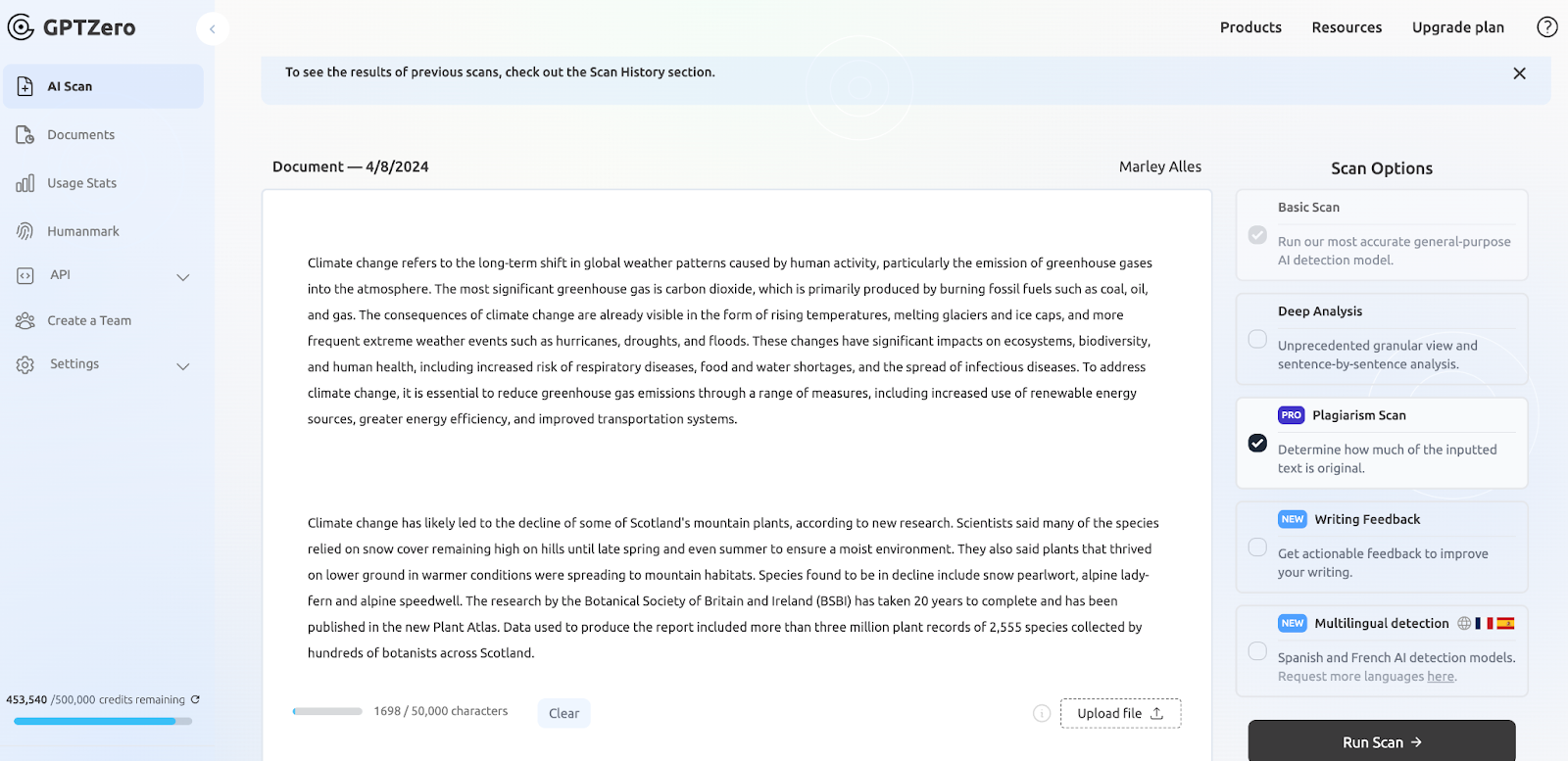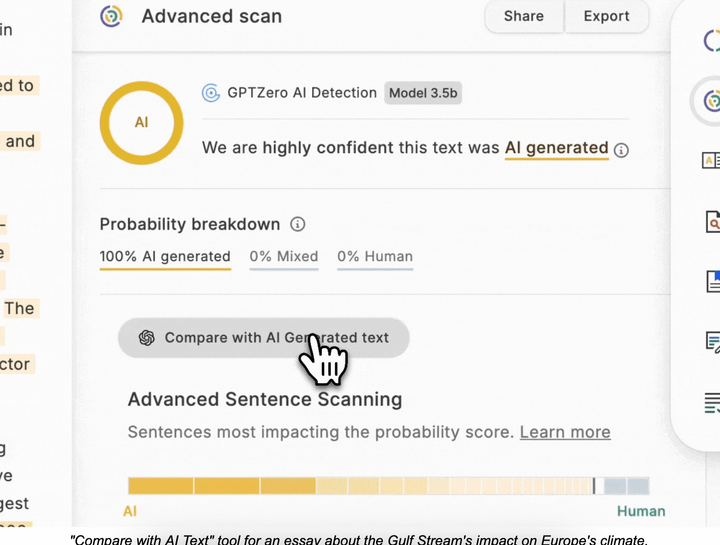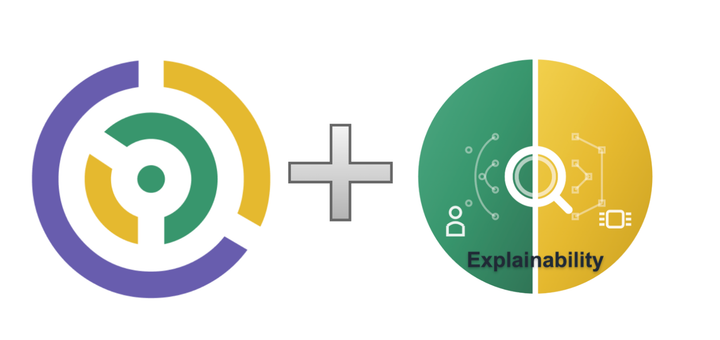Turnitin versus GPTZero
Compare the functionality of Turnitin to GPTZero, an advanced AI and plagiarism detection tool.

What is Turnitin?
Turnitin is used by academic institutions to detect plagiarism and AI in student writing.
Turnitin is a legacy system that is built for educators, not students. Students are unable to sign up without their teachers' support and they only receive a similarity percentage once they submit their papers.
How is GPTZero different?
Turnitin focuses on catching plagiarism and detecting AI-generated content in student work. Its core purpose lies in maintaining academic integrity by identifying and deterring instances of dishonesty in academic work. While it aims to maintain academic integrity, Turnitin's approach veers toward punitive stance, focusing on identifying academic dishonesty rather than fostering a deeper understanding of writing and research. GPTZero is more than an AI detector. It allows students and teachers to sign up for free and run AI detection, plagiarism and writing feedback scans prior to submitting their work (see below).

As a philosophical distinction, rather than solely focusing on plagiarism detection, GPTZero aims to empower the use of AI in educational settings by providing insights into how AI generates content. It prioritizes transparency and understanding over punitive measures, placing a strong emphasis on the belief that humans deserve the truth regarding AI-generated content. By prioritizing transparency and understanding, GPTZero seeks to bridge the gap between humans and AI. Through demystifying AI and encouraging engagement with AI, GPTZero’s mission is to enrich students' learning experiences and prepare them for an increasingly AI-driven world. See here for GPTZero CEO Edward Tian and Turnitin CPO Annie Chechitelli debating the role of AI in academic integrity and their differing philosophies.
Turnitin vs. GPTZero
A unique feature of GPTZero is it’s Chrome Extension. Origin by GPTZero allows users to scan text to check whether it was written by an AI or a human. It serves as a LMS, since individuals can use Origin on any website, either highlighting and right-clicking text or copy-pasting text into the Origin text box. The results save directly to the documents folder in GPTZero, so users can revisit their Origin scan results.
FAQs
What AI detector does Turnitin use?
Turnitin and GPTZero both built their own model leveraging Natural Language Processing that looks for similarities in submitted student work. Turnitin’s AI detection model is trained to detect AI generated content from GPT-3 and GPT-3.5 language models. Since inventing AI detection, GPTZero incorporates the latest research in detecting ChatGPT, GPT4, Google-Gemini, LLaMa, and new AI models, and investigating their sources.
How accurate is the Turnitin AI detector?
According to Turnitin, “our AI Writing detector’s false positive rate is less than 1% for documents with 20% or more AI writing (our tests showed that in cases where we detect less than 20% of AI writing in a document, there is a higher incidence of false positives)." However, it's important to note that this claim is based on tests conducted by Turnitin on their own dataset. The accuracy and reliability of the detector may vary in different contexts or when applied to documents outside of Turnitin's dataset. Overall, while Turnitin's AI Writing detector may provide a useful tool for identifying potential AI-generated content, users should interpret its results with caution and consider additional factors when assessing the originality of a document.
How accurate is GPTZero?
On our own internal evaluation dataset of over 25k documents, GPTZero achieves an accuracy of 90%. Importantly, the false positive rate is just under 1%, so most of the errors being made are AI classified as human. We are meticulous about including challenging samples in this evaluation dataset to get an accurate estimate of how our model performs on actual user submissions. Choosing an easier set of documents would make our performance metrics look great, but would be uninformative.
How does Turnitin work?
According to Turnitin, “Turnitin’s software takes what a student submits and we compare it to a massive database of content, including internet, academic, and student paper content, and we look for similarities. We report those similarities with a percentage, the percentage of the work submitted by the student that is similar to the content in our databases. In the report, a student or educator can dig into the details to see what, exactly, is matching, and how much.”
Turnitin’s AI detection uses algorithms to find patterns within student work that indicate plagiarism. It looks for “matching phrases, sentences, and paragraphs, as well as a shift in the writing style or tone, which could be a sign of irregularities.”
How does GPTZero work?
GPTZero uses a proprietary deep learning approach that combines information at both the sentence level and document level to make a prediction. We regularly adjust our architecture with the latest developments in language model research, along with our own optimizations for efficient inference. In addition to distinguishing between human and AI generated text, our model is also trained to identify text which is a combination of the two. This is an important distinction which helps accommodate a wider range of human-LLM interaction behaviors. We have a training database of over 30 million documents covering a broad range of writing styles, genres, and abilities, allowing us to tune our model to perform well on a set of documents that is most representative of our user submissions. What further distinguishes GPTZero from other approaches is an important post-processing step that is applied to adjust predictions such that false negatives are favored over false positives. This works by transforming low confidence AI/mixed predictions into human predictions at an appropriate rate as determined by a large validation set.
How does Turnitin detect plagiarism?
According to Turnitin their plagiarism detection software, “takes what a student submits and we compare it to a massive database of content, including internet, academic, and student paper content, and we look for similarities. We report those similarities with a percentage, the percentage of the work submitted by the student that is similar to the content in our databases. In the report, a student or educator can dig into the details to see what, exactly, is matching, and how much.”
How does GPTZero help educators teach?
Once AI is detected in writing, what is the next step for an educator? GPTZero is first to market in the next step after AI detection. Request Edits streamlines the revision process for any content identified as AI-generated. Upon detecting AI in the text, this feature allows teachers to request revisions directly from the student. Students can then replace AI-generated sentences with human-written text. When it has passed the human mark they can submit the revision for your review. Get on the waitlist by signing up for GPTZero for free.
GPTZero vs Turnitin philosophical differences
Philosophically distinct from Turnitin, GPTZero operates on the principle of transparency in machine learning. While Turnitin primarily serves plagiarism detection purposes, GPTZero extends its focus to leveraging AI to foster collaboration and mutual comprehension instead of confrontation. Its core values lie in fostering understanding and openness rather than punitive actions. GPTZero maintains that individuals have the right to know how AI produces content, emphasizing transparency as a means to bridge the human-AI gap.
See below for highlights of GPTZero Founder, Edward Tian, on a panel with CPO of Turnitin at ASU-GSV 2023
See below for highlights of GPTZero Founder, Edward Tian, on a panel with CEO of Turnitin at ASU-GSV 2023
Pricing for Turnitin vs. GPTZero
How much does Turnintin cost?
Turnitin is currently not public with their pricing structure as it is implemented at an institution level versus individual teacher accounts.
How much does GPTZero cost?
GPTZero pricing offers four flexible pricing options across free, essential, premium and professional tiers. These prices are for 2024 and reflect the price per month when billed annually.
- Free (no credit card required)
Gives you access to 10,000 words scanned a month, advanced AI detection, multilingual detection and writing feedback.
- Essential: $10/month
150,000 words/month, 100 scans an hour, 10 file limit per batch, advanced AI detection, plagiarism check, multilingual AI detection and writing feedback.
- Premium: $16/month
300,000 words/month, unlimited scans per hour, unlimited batch file uploads, advanced AI detection, plagiarism check, multilingual AI detection, writing feedback, ability to add team members.
- Professional: $23/month
500,000 words/month, unlimited scans per hour, unlimited batch file uploads, advanced AI detection, plagiarism check, multilingual AI detection, writing feedback, ability to add team members.
GPTZero Reviews and Testimonials
“The choice between GPTZero and Turnitin hinges on specific needs and preferences. While Turnitin remains the stalwart for educational institutions, GPTZero’s advanced language support and contextual understanding make it a formidable contender for diverse content analysis purposes.” - Analyse AI Tools
“GPTZero provides accurate results in identifying AI-generated text. Though it’s been developed for teachers, students, and writers, other professions can also benefit from it.” - MSPowerUser
“One of the critical factors that determine user experience is the tool’s accuracy. Users have praised GPTZero for its high accuracy in identifying AI-authored content. Its reliability, even when dealing with newer, more sophisticated AI models, has been a major plus in the eyes of its users.” - Sci Journal
“GPTZero is one of the most straightforward tools we tested — especially if you only need to check a few pieces of content. This is because you don’t need a subscription or account for a basic scan. Simply paste your content into the web interface. GPTZero also has a novel feature that recreates typing behavior in Word or Google docs, which is a nifty way to be certain that a human typed rather than pasted content.” - Crowd Content


